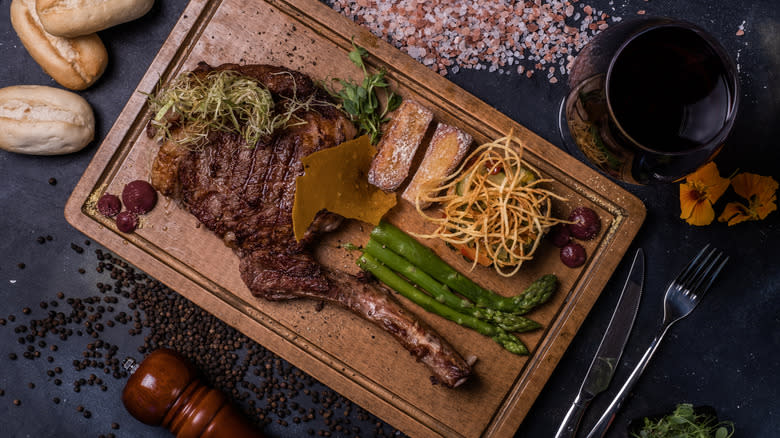One Of The Biggest Red Flags At A Steakhouse Starts With The Menu

It might be fun and informative to talk to your butcher about the meats on display as you browse your local grocery store when your shopping for the perfect cut, but when you sit down to dinner at a steakhouse, the only thing on your mind is leisure (and maybe the company of your dining companions). An appetite for learning may make for a good market trip, but at dinnertime, your appetite is all about steak -- and at a quality steakhouse, the menu should answer all of your questions without you having to ask.
Luckily for discerning foodies, one of the biggest red flags at a steakhouse can be spotted before your food even arrives at the table. A good steakhouse with quality meat will have a descriptive menu that explains what type of meat is used, what grade it is, and where it comes from. Thorough information shows that the culinary team takes its steak seriously and has a deep understanding of different flavors and textures.
When you don't see that info printed on the menu, it's a red flag. Not being up front about all of the important info, especially regarding the steaks themselves, might mean that the quality of the ingredients (and, by extension, the general quality of the restaurant) isn't something to brag about. For top-tier chefs, only top-tier ingredients will do. Uncompromising ingredients make for dishes they can feel good about putting their name on; their professional reputation and the success of the restaurant depend on it.
Read more: The Most Popular Cuts Of Steak Ranked Worst To Best
Show What You Know

At world-renowned Peter Luger Steakhouse in Brooklyn, the menu includes an entire block of information about the restaurant's meat: "USDA Prime Beef, family-selected, dry-aged in our own aging box." All this info, and yet the menu doesn't include prices (classic fancy steakhouse move, but we digress). Longstanding steakhouse icon Barry's Downtown Prime on the Las Vegas Strip takes it a step further: Its menu lists where each steak was sourced from. The wet-aged 12-ounce rib cap "Barry's Steak," for instance, comes from Creekstone Farms in Kansas, while the 8-ounce wet-aged filet mignon comes from Revier Cattle Co. in Minnesota. As a general rule, look for the words "USDA Prime" and "USDA Choice." Despite its popularity, wagyu beef is not graded by the USDA, so ask about the source and grade if you're unsure.
There are, of course, exceptions to this menu rule, particularly steakhouses with proprietary butchering practices or rotating menus. At Bateau, a steakhouse in Seattle, the only steak-related menu description reads, "Our approach to preparing beef is about the whole animal. Steaks butchered in-house, sold by weight, and served á la carte with your choice of butter. See chalkboard for today's cuts." In cases like these, feel free to ask your server to share more information before deciding. Foodies are a passionate group of people, and even during a dinner rush, a proud, knowledgeable chef will be glad to let you know that they know their stuff when you order at your favorite steakhouse.
Read the original article on Tasting Table.


